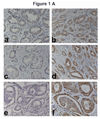Osteopontin and interleukin-8 expression is independently associated with prostate cancer recurrence
- PMID: 18593988
- PMCID: PMC2665724
- DOI: 10.1158/1078-0432.CCR-08-0738
Osteopontin and interleukin-8 expression is independently associated with prostate cancer recurrence
Abstract
Purpose: Lack of reliable biomarkers limits accurate prediction of prostate-specific antigen biochemical recurrence (disease progression) in prostate cancer. The two inflammatory chemokines, osteopontin and interleukin-8 (IL-8), are associated with tumor angiogenesis and metastasis. We investigated whether osteopontin and IL-8 expression in prostate cancer correlates with disease progression.
Experimental design: Archival prostatectomy specimens (n = 103) were obtained from patients with minimum 72-month follow-up. Osteopontin and IL-8 expression was evaluated by immunohistochemistry and graded for intensity and the area. Association of osteopontin and IL-8 staining with biochemical recurrence was evaluated by univariate and multivariate models.
Results: In tumor cells, osteopontin and IL-8 staining was higher in the recurred group (203.2 +/- 78.4; 181.1 +/- 89.3) than in the nonrecurred group (122.7 +/- 76.6; 96.4 +/- 85.6; P < 0.001). Higher osteopontin and IL-8 staining was also observed in benign areas adjacent to tumor in the recurred group, than in nonrecurred group. In univariate analysis, except age, all preoperative and postoperative variables and osteopontin and IL-8 staining scores were significantly associated with biochemical recurrence (P < 0.05). In multivariate analysis, margin status and osteopontin staining independently associated with biochemical recurrence within 72 months. Osteopontin, either alone or with IL-8 and seminal vesicle invasion, was a significant variable in predicting biochemical recurrence within 24 months. Osteopontin and IL-8 staining predicted recurrence with high sensitivity (75.5%; 73.6%) and specificity (76%; 70.6%).
Conclusion: In prostatectomy specimens, osteopontin expression is independently associated with biochemical recurrence. Both osteopontin and IL-8 may be predictors of early disease progression.
Figures



Similar articles
-
Cyclooxygenase-2 (COX-2) expression is an independent predictor of prostate cancer recurrence.Int J Cancer. 2006 Sep 1;119(5):1082-7. doi: 10.1002/ijc.21749. Int J Cancer. 2006. PMID: 16557596
-
Chemokine markers predict biochemical recurrence of prostate cancer following prostatectomy.Clin Cancer Res. 2008 Dec 1;14(23):7790-7. doi: 10.1158/1078-0432.CCR-08-1716. Clin Cancer Res. 2008. PMID: 19047106 Free PMC article.
-
Intrinsic markers of tumour hypoxia and angiogenesis in localised prostate cancer and outcome of radical treatment: a retrospective analysis of two randomised radiotherapy trials and one surgical cohort study.Lancet Oncol. 2008 Apr;9(4):342-51. doi: 10.1016/S1470-2045(08)70076-7. Epub 2008 Mar 17. Lancet Oncol. 2008. PMID: 18343725
-
Comparison of the prognostic potential of hyaluronic acid, hyaluronidase (HYAL-1), CD44v6 and microvessel density for prostate cancer.Int J Cancer. 2004 Oct 20;112(1):121-9. doi: 10.1002/ijc.20368. Int J Cancer. 2004. PMID: 15305383
-
Angiogenesis, p53, bcl-2 and Ki-67 in the progression of prostate cancer after radical prostatectomy.Eur Urol. 1999;35(5-6):399-407. doi: 10.1159/000019916. Eur Urol. 1999. PMID: 10325496 Review.
Cited by
-
The role of microenvironment in tumor angiogenesis.J Exp Clin Cancer Res. 2020 Sep 30;39(1):204. doi: 10.1186/s13046-020-01709-5. J Exp Clin Cancer Res. 2020. PMID: 32993787 Free PMC article. Review.
-
Profiles of Radioresistance Mechanisms in Prostate Cancer.Crit Rev Oncog. 2018;23(1-2):39-67. doi: 10.1615/CritRevOncog.2018025946. Crit Rev Oncog. 2018. PMID: 29953367 Free PMC article. Review.
-
IL-8 secretion in primary cultures of prostate cells is associated with prostate cancer aggressiveness.Res Rep Urol. 2014 May 9;6:27-34. doi: 10.2147/RRU.S58643. eCollection 2014. Res Rep Urol. 2014. PMID: 24892030 Free PMC article.
-
Absence of nuclear receptors LXRs impairs immune response to androgen deprivation and leads to prostate neoplasia.PLoS Biol. 2020 Dec 7;18(12):e3000948. doi: 10.1371/journal.pbio.3000948. eCollection 2020 Dec. PLoS Biol. 2020. PMID: 33284790 Free PMC article.
-
Is Osteopontin a Good Marker for Bone Metastasis in Canine Mammary Gland Tumor and Prostate Cancer?Animals (Basel). 2023 Oct 14;13(20):3211. doi: 10.3390/ani13203211. Animals (Basel). 2023. PMID: 37893935 Free PMC article.
References
-
- Amling CL. Biochemical recurrence after localized treatment. Urol Clin North Am. 2006;33:147–159. - PubMed
-
- Routh JC, Leibovich BC. Adenocarcinoma of the prostate: epidemiological trends, screening, diagnosis, and surgical management of localized disease. Mayo Clin Proc. 2005;80:899–907. - PubMed
-
- Sodek J, Ganss B, McKee MD. Osteopontin. Crit Rev Oral Biol Med. 2000;11:279–303. - PubMed
-
- Rangaswami H, Bulbule A, Kundu GC. Osteopontin: role in cell signaling and cancer progression. Trends Cell Biol. 2006;16:79–87. - PubMed
Publication types
MeSH terms
Substances
Grants and funding
LinkOut - more resources
Full Text Sources
Other Literature Sources
Medical
Research Materials

